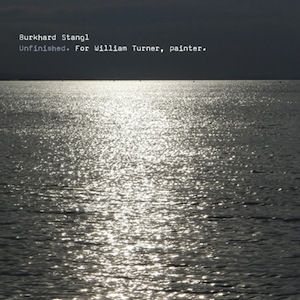 Following a visit to the Tate Gallery and seeing JMW Turner’s paintings, Burkhard Stangl began working on a way to represent these painted landscapes as musical soundscapes. Focusing on Turner’s unfinished works, Stengl never truly gets into the same sphere as Turner. The resulting album is a collection of superficially nice music that has little below the surface, in opposition to the elegance and depth of Turner’s masterful compositions.
Following a visit to the Tate Gallery and seeing JMW Turner’s paintings, Burkhard Stangl began working on a way to represent these painted landscapes as musical soundscapes. Focusing on Turner’s unfinished works, Stengl never truly gets into the same sphere as Turner. The resulting album is a collection of superficially nice music that has little below the surface, in opposition to the elegance and depth of Turner’s masterful compositions.
Every New Year in the National Gallery of Ireland in Dublin, a room is set aside to show a selection of Turner’s watercolors. Left by Henry Vaughan, he requested that they only be shown in January when the light was softest to do as little damage as possible to the delicate paintings. To this day, despite advances in artificial lighting, the gallery continues this tradition. This creates a sense of occasion and ceremony to the annual exhibition, the room feeling like a chapel dedicated to Turner where the works are viewed in a hushed atmosphere.
Stangl approaches Turner with a similar reverence and the music seems to be a soundtrack for such rapt and inward-facing contemplation. Using his guitar to create spacious and slowly evolving pieces, the music here is not unlike the approach that Dylan Carlson is employing in his drcarlsonalbion project. However, as with Carlson’s most recent work, Stangl’s playing does not really connect with me in any deep way. It sounds pretty but for the most part, the pieces (long pauses interspersed with small melodic units) feel contrived and lacking in emotion, as if the idea for the composition trumps the listening of the piece. Based on Stangl’s comments about the album, I am certain he is sincere in this tribute to Turner but his words seem at odds with the final form of the album.
During the first movement of "#1 Unfinished - Mellow; Waiting; Longing," the lightly strummed guitar is joined by a recording of what seems to be children playing in the rain. Deliberately obscured, the field recording fades into the murk much like the landscape fades into the canvas in Turner’s work and is a nice nod to the painter’s style. However, by leaving the opening movement unresolved like the unfinished paintings that Stangl became enamoured with, it instead makes the music feel throwaway and unwanted. An unfinished painting has a mystery and a longing to it that is completely absent in "Mellow." Especially given that it runs for about 15 minutes, about 12 minutes longer than it really should have.
Luckily, there is more to say about the second movement, "Waiting," which also goes nowhere but in a beautiful, hazy way. The guitar sounds terrific, a pulsing tremolo and slight reverb bringing to mind Stangl’s work on Fennesz’s Venice combined with what sounds like an electric organ being played ever so softly. Here Stangl’s music comes closest to achieving the goal of approaching Turner’s style from a musical perspective. The final movement, "Longing," follows the lead of "Waiting" yet never fully engages in the same way. Equally, "#2 Unfinished – Sailing" begins with a nice bit of playing but ends up going in circles for about quarter of an hour, leaving the air heavy with tedium. There is the momentary instance of a nice lick or resonance here and there though that is the best that can be said of the piece.
As if to highlight how unnecessarily long these pieces are, "#3 Unfinished – Ending" clocks in at just under three minutes and does everything that Stangl set out to do. Granted it is a lot busier than the previous pieces which might be contradictory to some notions of Turner’s work but here the guitar has both a soft, foggy presence with elements of sharp detail sticking out like gondolas on a misty Venetian canal. If Stangl had explored more in this direction, Unfinished. For William Turner, Painter would have been a much different, more effective album.
samples:
 
Read More

